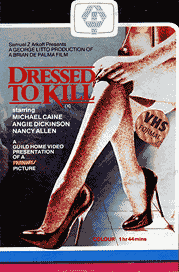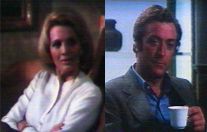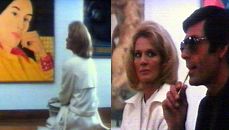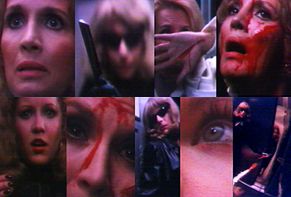(1980,US)
![]()
"BRIAN DE PALMA, MASTER OF THE MACABRE,
INVITES YOU TO A SHOWING OF THE LATEST FASHION
... IN MURDER."

![]()
"BRIAN DE PALMA, MASTER OF THE MACABRE,
INVITES YOU TO A SHOWING OF THE LATEST FASHION
... IN MURDER."
directed by: Brian De Palma (back of video blurb): "She goes by the name of Bobbi, tall, blonde and a vicious killer.
He is Dr Robert Elliot, good looking, with a warm open smile. He practises psychiatry in New York's fashionable East Side. Obviously, he is successful. One of his patients is Kate Miller an attractive wowan suffering from erotic fantasies so vivid that she has difficulty seperating her dreams from reality.
Sexuality, violence and excitment together create one of the most horrifying and erotic films Hollywood has ever made- WATCH IT!"
choice dialogue:
starring: Michael Caine, Angie Dickinson, Nancy Allen, Keith Gordon, Dennis Franz, David Marulies, Ken Baker, Susanna Clemm, Brandon Maggart, Amalie Collier, Mary Davenport
(review by Mike Sutton)
DRESSED TO KILL aroused much controversy when it was first released and should perhaps be put in context: September 1980 was in the midst of the panic about the "Yorkshire Ripper". He was still on the loose, the police had no clue about how to catch him, having interrogated virtually every man in the area, and women's groups were protesting outside sex shops and cinemas, about a culture which, they claimed, portrayed women as either sex objects or sexually promiscuous victims. DRESSED TO KILL had the misfortune to be on general release at the time of much campaigning about "violence against women" and the police attitude towards it - which many women felt was too casual.
No-one could claim that Brian DePalma is exactly a feminist director, or that his films are free of sexism. However, it could be argued that, unlike Spielberg or Scorsese, he has provided many good roles for women in his films - as both victims and aggressors - and has been willing to examine the culture in which violence against women is perceived as acceptable. Whether his films are part of that culture is another matter, although his hilarious slasher pastiche at the beginning of BLOW OUT does indicate that he is well aware of the debate and his own position within it.
 DRESSED TO KILL deals with two women. One, Kate Miller, is
dissatisfied with her life and particularly with her marriage. Her
dreams of sexual satisfaction are rudely interrupted by her husband's
forcing himself upon her first thing in the morning. Despite what some
writers have argued, this is not a rape fantasy, since Kate clearly
indicates her disgust at her husband's behaviour; "He gave one of his
'wham bam thankyou ma'am specials this morning." Desperate for
happiness, she goes to an analyst, Dr Robert Elliott (Michael Caine) who
assures her that she is still attractive, but gently rebuffs her
advances. Elliott is getting messages on his answerphone from an angry
patient, Bobbi, and his razor seems to have gone missing.
DRESSED TO KILL deals with two women. One, Kate Miller, is
dissatisfied with her life and particularly with her marriage. Her
dreams of sexual satisfaction are rudely interrupted by her husband's
forcing himself upon her first thing in the morning. Despite what some
writers have argued, this is not a rape fantasy, since Kate clearly
indicates her disgust at her husband's behaviour; "He gave one of his
'wham bam thankyou ma'am specials this morning." Desperate for
happiness, she goes to an analyst, Dr Robert Elliott (Michael Caine) who
assures her that she is still attractive, but gently rebuffs her
advances. Elliott is getting messages on his answerphone from an angry
patient, Bobbi, and his razor seems to have gone missing.
Frustrated, Kate goes to the art gallery where, in DePalma's finest scene, she allows herself to be seduced by a "tall dark handsome stranger". The initial moments of the scene look rather like a homage to VERTIGO, but what follows has a warm sensuousness which is not remotely Hitchcockian. He looks distinctly like her dream lover, and he plays a love game with her, through the art gallery. This is shot with a sort of dreamlike ambience, similar to the locker room in CARRIE. We are watching a dream as surely as we are at the beginning, when Angie Dickinson is in the shower and is given the perfect young body she might once have had, courtesy of a stand-in.
 Kate returns to the mysterious stranger's apartment, after a grope in
the back of a taxi. This is watched by the driver, the first in a series
of images of voyeurism, sometimes well intentioned, sometimes not.
However, yet again, Kate's reverie is cruelly interrupted when she looks
at a letter on her lover's desk, which shows him to have VD. Nothing, we
feel, is ever going to go right for Kate; life plays nasty tricks on
her, and, crucially, we feel sorry for her. Dickinson is a very likeable
actress and adept at comic touches; we want to follow her through the
film and see if she eventually finds some sort of satisfaction. The
parallels with Marion Crane in PSYCHO are, one assumes, deliberate,
although it has to be said that DePalma shows much more interest in his
female victim than Hitchcock shows in his.
Kate returns to the mysterious stranger's apartment, after a grope in
the back of a taxi. This is watched by the driver, the first in a series
of images of voyeurism, sometimes well intentioned, sometimes not.
However, yet again, Kate's reverie is cruelly interrupted when she looks
at a letter on her lover's desk, which shows him to have VD. Nothing, we
feel, is ever going to go right for Kate; life plays nasty tricks on
her, and, crucially, we feel sorry for her. Dickinson is a very likeable
actress and adept at comic touches; we want to follow her through the
film and see if she eventually finds some sort of satisfaction. The
parallels with Marion Crane in PSYCHO are, one assumes, deliberate,
although it has to be said that DePalma shows much more interest in his
female victim than Hitchcock shows in his.
But DePalma is about to play the cruellest trick of all. In a variation on Janet Leigh's death in PSYCHO, Kate Miller is killed in the lift, after what seems, in retrospect, to be an unconscionably long wait. Typically, DePalma stretches out the moment of crisis, although unlike the bucket of blood in CARRIE, this is played for a sudden shock, rather than achingly drawn-out suspense. She is razor-slashed by a figure with blonde hair, dark glasses and a razor. The killer gets away, leaving Kate dead and jamming the lift door. DePalma seems to be making a comment here about the randomness of violence in modern society; or maybe he's just getting his kicks from a gory murder scene ... ? On balance, I think he's doing both. DePalma is fascinated by the aesthetics of gory death, staging this murder as a series of brief images - although he keeps it relatively realistic instead of abstracting it, as Hitchcock did in PSYCHO.
Why is Kate killed? The feminist view would have us believed that
DePalma is saying that she is a loose woman who  must be punished. Cries
of "misogyny" are once again directed towards DePalma's work. But if
that was his message, why (a) cast such a likeable actress in the role
and encourage her to be so sympathetic and (b) allow an even "looser"
woman to survive the film ? In plot terms, there is a fairly logical
explanation for the murder, but it also fits in with DePalma's world
view, in which "nice" characters always seem to come to a bad end. The
killings of Betty Buckley in CARRIE and even more so, Carrie Snodgrass
in THE FURY are pointless and are not remarked upon. He seems to
believe in a higher power who is little more than a trickster, playing
vicious jokes for no good reason on people who don't deserve their
fates. Right from the first murder in SISTERS, DePalma has put
likeable and sympathetic characters in the firing line - the process
reached an apotheosis in THE FURY when Kirk Douglas, the supposed hero
of the film, dies in such an off-hand manner than one isn't even sure
what's happened to him.
must be punished. Cries
of "misogyny" are once again directed towards DePalma's work. But if
that was his message, why (a) cast such a likeable actress in the role
and encourage her to be so sympathetic and (b) allow an even "looser"
woman to survive the film ? In plot terms, there is a fairly logical
explanation for the murder, but it also fits in with DePalma's world
view, in which "nice" characters always seem to come to a bad end. The
killings of Betty Buckley in CARRIE and even more so, Carrie Snodgrass
in THE FURY are pointless and are not remarked upon. He seems to
believe in a higher power who is little more than a trickster, playing
vicious jokes for no good reason on people who don't deserve their
fates. Right from the first murder in SISTERS, DePalma has put
likeable and sympathetic characters in the firing line - the process
reached an apotheosis in THE FURY when Kirk Douglas, the supposed hero
of the film, dies in such an off-hand manner than one isn't even sure
what's happened to him.
Kate's murder is witnessed by a prostitute, Liz Blake, who assumes she will be the next victim. As played by Nancy Allen, Liz is smart, funny and completely in control of her life. She reports the matter to the police, to be rewarded with sarcasm from a misogynistic cop - played by Dennis Franz, a DePalma regular in this period, adept at playing amusingly sleazy characters.